Are Coal-Hosted Gallium-Rich Ores Elastically Detectable: A Rock-Physics Modeling Perspective
Abstract
:1. Introduction
2. Geological Background
2.1. Geological Setting
2.2. Core Samples
2.3. Mineral Enrichment Characteristics
3. Methods
3.1. VRH Average
3.2. DEM Model
3.3. Gassmann Fluid Replacement
3.4. Rock-Physics Modeling Workflow
3.5. Monte Carlo Simulation
4. Results
4.1. Contents in Volume
4.2. Component Moduli and Density
4.3. Elastic Parameters of Cores
4.4. Cross-Plot Characteristics of Cores
5. Discussion
5.1. Cross-Plot Characteristics after Monte Carlo Simulations
5.2. Interpretation Template for Boehmite Content
6. Conclusions
- (1)
- The gallium contents in cores of No. 6 coal correlate to boehmite content.
- (2)
- Mineral compositions and contents are critical factors influencing the elastic parameters of cores. Although the elastic parameters in No. 6 coal have vertical heterogeneities, their values are still within the range of bituminous coal [29].
- (3)
- The preferred parameters for distinguishing different mineral-rich cores are the bulk modulus and moduli ratio. The cross plot of bulk modulus vs. moduli ratio can qualitatively distinguish measured cores and Monte-Carlo simulated realizations into different mineral-rich and saturation states properly.
- (4)
- Interpretation templates can quantitatively interpret the boehmite contents in the boehmite-rich cores with acceptable errors considering dry and water-saturated states. With the correlation between boehmite and gallium, researchers can quantitatively interpret the gallium content in cores.
- (5)
- Coal-hosted gallium-rich ores in No. 6 coal and coalbeds with similar mineral composition are elastically detectable, but the detectability of ores hosted in other coalbeds needs further study.
Author Contributions
Funding
Data Availability Statement
Acknowledgments
Conflicts of Interest
References
- Qin, S.; Sun, Y.; Li, Y.; Wang, J.; Zhao, C.; Gao, K. Coal deposits as promising alternative sources for gallium. Earth-Sci. Rev. 2015, 150, 95–101. [Google Scholar] [CrossRef]
- Dai, S.; Finkelman, R.B. Coal as a promising source of critical elements: Progress and future prospects. Int. J. Coal Geol. 2018, 186, 155–164. [Google Scholar] [CrossRef]
- Dai, S.; Jiang, Y.; Ward, C.R.; Gu, L.; Seredin, V.V.; Liu, H.; Zhou, D.; Wang, X.; Sun, Y.; Zou, J.; et al. Mineralogical and geochemical compositions of the coal in the Guanbanwusu Mine, Inner Mongolia, China: Further evidence for the existence of an Al (Ga and REE) ore deposit in the Jungar Coalfield. Int. J. Coal Geol. 2012, 98, 10–40. [Google Scholar] [CrossRef]
- Dai, S.; Li, D.; Chou, C.-L.; Zhao, L.; Zhang, Y.; Ren, D.; Ma, Y.; Sun, Y. Mineralogy and geochemistry of boehmite-rich coals: New insights from the Haerwusu Surface Mine, Jungar Coalfield, Inner Mongolia, China. Int. J. Coal Geol. 2008, 74, 185–202. [Google Scholar] [CrossRef]
- Dai, S.; Ren, D.; Li, S. Discovery of the superlarge gallium ore deposit in Jungar, Inner Mongolia, North China. Chin. Sci. Bull. 2006, 51, 2243–2252. [Google Scholar] [CrossRef]
- Li, J.; Zhuang, X.; Yuan, W.; Liu, B.; Querol, X.; Font, O.; Moreno, N.; Li, J.; Gang, T.; Liang, G. Mineral composition and geochemical characteristics of the Li-Ga-rich coals in the Buertaohai-Tianjiashipan mining district, Jungar Coalfield, Inner Mongolia. Int. J. Coal Geol. 2016, 167, 157–175. [Google Scholar] [CrossRef]
- Wang, W.; Qin, Y.; Liu, X.; Zhao, J.; Wang, J.; Wu, G.; Liu, J. Distribution, occurrence and enrichment causes of gallium in coals from the Jungar Coalfield, Inner Mongolia. Sci. China Earth Sci. 2011, 54, 1053–1068. [Google Scholar] [CrossRef]
- Zhang, P.; Han, Z.; Jia, J.; Wei, C.; Liu, Q.; Wang, X.; Zhou, J.; Li, F.; Miao, S. Occurrence and Distribution of Gallium, Scandium, and Rare Earth Elements in Coal Gangue Collected from Junggar Basin, China. Int. J. Coal Prep. Util. 2017, 39, 389–402. [Google Scholar] [CrossRef]
- Dai, S.; Yan, X.; Ward, C.R.; Hower, J.C.; Zhao, L.; Wang, X.; Zhao, L.; Ren, D.; Finkelman, R.B. Valuable elements in Chinese coals: A review. Int. Geol. Rev. 2016, 60, 590–620. [Google Scholar] [CrossRef]
- Gandhi, S.M.; Sarkar, B. Essentials of Mineral Exploration and Evaluation; Elsevier: Amsterdam, The Netherlands, 2016. [Google Scholar]
- Chen, J.; Chen, P.; Yao, D.; Huang, W.; Tang, S.; Wang, K.; Liu, W.; Hu, Y.; Li, Q.; Wang, R. Geochemistry of uranium in Chinese coals and the emission inventory of coal-fired power plants in China. Int. Geol. Rev. 2017, 60, 621–637. [Google Scholar] [CrossRef]
- Dai, S.; Yang, J.; Ward, C.R.; Hower, J.C.; Liu, H.; Garrison, T.M.; French, D.; O’Keefe, J.M. Geochemical and mineralogical evidence for a coal-hosted uranium deposit in the Yili Basin, Xinjiang, northwestern China. Ore Geol. Rev. 2015, 70, 1–30. [Google Scholar] [CrossRef]
- Scheller, K.W.; Elliott, W.S. Geochemical and γ ray characterization of Pennsylvanian black shales: Implications for elevated home radon levels in Vanderburgh County, Indiana. J. Environ. Radioact. 2015, 148, 154–162. [Google Scholar] [CrossRef]
- Zhao, J.; Tang, D.; Qin, Y.; Xu, H. Experimental study on structural models of coal macrolithotypes and its well logging responses in the Hancheng area, Ordos Basin, China. J. Pet. Sci. Eng. 2018, 166, 658–672. [Google Scholar] [CrossRef]
- Mavko, G.; Mukerji, T.; Dvorkin, J. The Rock Physics Handbook, 3rd ed.; Cambridge University Press: Cambridge, UK, 2019. [Google Scholar]
- Avseth, P.; Mukerji, T.; Mavko, G. Quantitative Seismic Interpretation: Applying Rock Physics Tools to Reduce Interpretation Risk, Paperback ed.; Cambridge University Press: Cambridge, UK; New York, NY, USA, 2010. [Google Scholar]
- Chen, T.; Wang, X.; Mukerji, T. In situ identification of high vertical stress areas in an underground coal mine panel using seismic refraction tomography. Int. J. Coal Geol. 2015, 149, 55–66. [Google Scholar] [CrossRef]
- Chen, T.; Lin, Z.; Liu, Z.; Mukerji, T. A Comparative Experiment on Heterogeneous Distributions of Stress Field for Underground Panels With Different Geological Setting in North China. IEEE Trans. Geosci. Remote Sens. 2021, 60, 1–15. [Google Scholar] [CrossRef]
- Zhao, L.; Chen, T.; Mukerji, T.; Tang, G. Bulk modulus for fluid-saturated rocks at high frequency: Modification of squirt flow model proposed by Mavko & Jizba. Geophys. J. Int. 2021, 225, 1714–1724. [Google Scholar] [CrossRef]
- Zhao, L.; Chen, T.; Mukerji, T.; Zhang, M.; Xing, T. Brown and Korringa’s expression for the saturated bulk modulus at high frequencies: Modification of Mavko and Jizba’s squirt flow model. Geophysics 2022, 87, MR201–MR208. [Google Scholar] [CrossRef]
- Zhao, L.; Chen, T.; Tang, G. Bulk modulus for fluid-saturated rocks at intermediate frequencies: Modification of squirt flow model proposed by Gurevich et al. Geophys. J. Int. 2021, 226, 246–255. [Google Scholar] [CrossRef]
- Batzle, M.; Wang, Z. Seismic properties of pore fluids. Geophysics 1992, 57, 1396–1408. [Google Scholar] [CrossRef] [Green Version]
- Han, D.-H. Effects of Porosity and Clay Content on Acoustic Properties of Sandstones and Unconsolidated Sediments; Stanford University: Stanford, CA, USA, 1987. [Google Scholar]
- Karimpouli, S.; Tahmasebi, P.; Saenger, E.H. Estimating 3D elastic moduli of rock from 2D thin-section images using differential effective medium theory. Geophysics 2018, 83, MR211–MR219. [Google Scholar] [CrossRef]
- Bagdassarov, N. Fundamentals of Rock Physics; Cambridge University Press: Cambridge, UK; New York, NY, USA, 2021. [Google Scholar]
- Li, Z.; Ouyang, F.; Xiao, Z.J.; Liu, X.Z.; He, Y.X.; Zhao, J.G. Experimental and theoretical verification of the effect of fluid viscosity on the dispersion and decay of sandstone elastic modulus. Chin. J. Geophys.-Ch. 2022, 65, 2179–2197. [Google Scholar] [CrossRef]
- Krawiec, K. Dynamic elastic properties of the hard coal seam at a depth of around 1260 m. Gospod. Surowcam. Min. 2021, 37, 159–175. [Google Scholar] [CrossRef]
- Ambati, V.; Sharma, S.; Babu, M.N.; Nair, R.R. Laboratory measurements of ultrasonic wave velocities of rock samples and their relation to log data: A case study from Mumbai offshore. J. Earth Syst. Sci. 2021, 130, 176. [Google Scholar] [CrossRef]
- Morcote, A.; Mavko, G.; Prasad, M. Dynamic elastic properties of coal. Geophysics 2010, 75, E227–E234. [Google Scholar] [CrossRef]
- Chen, H.; Jiang, B.; Chen, T.; Xu, S.; Zhu, G. Experimental study on ultrasonic velocity and anisotropy of tectonically deformed coal. Int. J. Coal Geol. 2017, 179, 242–252. [Google Scholar] [CrossRef]
- Chen, T.; Ma, G.; Wang, X.; Cui, R. Deformation Degree Estimate for Coal Seam using Well Logs as Input: A Case Study. J. Environ. Eng. Geophys. 2018, 23, 89–101. [Google Scholar] [CrossRef]
- Wang, X.; Li, Y.; Chen, T.; Yan, Q.; Ma, L. Quantitative thickness prediction of tectonically deformed coal using Extreme Learning Machine and Principal Component Analysis: A case study. Comput. Geosci. 2017, 101, 38–47. [Google Scholar] [CrossRef]
- Liu, J.; Liu, D.; Cai, Y.; Gan, Q.; Yao, Y. Effects of water saturation on P-wave propagation in fractured coals: An experimental perspective. J. Appl. Geophys. 2017, 144, 94–103. [Google Scholar] [CrossRef]
- Wang, H.; Pan, J.; Wang, S.; Zhu, H. Relationship between macro-fracture density, P-wave velocity, and permeability of coal. J. Appl. Geophys. 2015, 117, 111–117. [Google Scholar] [CrossRef]
- Liu, D.; Li, L.; Zhao, Z.; Chen, W.; Cai, Y.; Qiu, Y.; Zhou, Y. P-wave and S-wave response of coal rock containing gas-water with different saturation: An experimental perspective. Front. Earth Sci. 2022, 1–9. [Google Scholar] [CrossRef]
- Wang, G.; Li, J.; Liu, Z.; Qin, X.; Yan, S. Relationship between wave speed variation and microstructure of coal under wet conditions. Int. J. Rock Mech. Min. Sci. 2020, 126, 104203. [Google Scholar] [CrossRef]
- Dong, S.H.; Wu, H.B.; Li, D.H.; Huang, Y.P. Experimental Study of Ultrasonic Velocity and Anisotropy in Coal Samples. J. Seism. Explor. 2016, 25, 131–146. [Google Scholar]
- Huang, Y.; Wei, M.; Malekian, R.; Zheng, X. CBM Reservoir Rock Physics Model and Its Response Characteristic Study. IEEE Access 2017, 5, 1. [Google Scholar] [CrossRef]
- Ba, J.; Hu, P.; Tan, W.; Müller, T.M.; Fu, L.-Y. Brittle mineral prediction based on rock-physics modelling for tight oil reservoir rocks. J. Geophys. Eng. 2021, 18, 970–983. [Google Scholar] [CrossRef]
- Ghosh, R.; Sarkar, P.; Singh, K.H. Elastic Anisotropy Modeling of Organic-Rich Lower Gondwana Shale in Eastern India (Nov, 10.1007/s00024-020-02620-y, 2020). Pure Appl. Geophys. 2021, 178, 689. [Google Scholar] [CrossRef]
- David, E.; Zimmerman, R. Elastic moduli of solids containing spheroidal pores. Int. J. Eng. Sci. 2011, 49, 544–560. [Google Scholar] [CrossRef]
- Johansen, J.L.; David, M.-F.; Ekelund, F.; Vestergård, M. Wood ash decreases cadmium toxicity to the soil nematode Caenorhabditis elegans. Ecotoxicol. Environ. Saf. 2019, 172, 290–295. [Google Scholar] [CrossRef]
- Markov, M.; Levine, V.; Mousatov, A.; Kazatchenko, E. Elastic properties of double-porosity rocks using the differential effective medium model. Geophys. Prospect. 2005, 53, 733–754. [Google Scholar] [CrossRef]
- Misaghi, A.; Negahban, S.; Landrø, M.; Javaherian, A. A comparison of rock physics models for fluid substitution in carbonate rocks. Explor. Geophys. 2010, 41, 146–154. [Google Scholar] [CrossRef]
- Fender, T.D.; Rouainia, M.; Van Der Land, C.; Jones, D.M.; Mastalerz, M.; Hennissen, J.; Graham, S.P.; Wagner, T. Geomechanical properties of coal macerals; measurements applicable to modelling swelling of coal seams during CO2 sequestration. Int. J. Coal Geol. 2020, 228, 103528. [Google Scholar] [CrossRef]
- Fankhänel, J.; Silbernagl, D.; Khorasani, M.G.Z.; Daum, B.; Kempe, A.; Sturm, H.; Rolfes, R. Mechanical Properties of Boehmite Evaluated by Atomic Force Microscopy Experiments and Molecular Dynamic Finite Element Simulations. J. Nanomater. 2016, 2016, 91–117. [Google Scholar] [CrossRef]
- Zhang, C.; Li, L.; Yuan, Z.; Xu, X.; Song, Z.; Zhang, Y.R. Mechanical properties of siderite and hematite from DFT calculation. Miner. Eng. 2019, 146, 106107. [Google Scholar] [CrossRef]
- Berryman, J.G.; Milton, G.W. Exact results for generalized Gassmann’s equations in composite porous media with two constituents. Geophysics 1991, 56, 1950–1960. [Google Scholar] [CrossRef]
- Ba, J.; Cao, H.; Carcione, J.M.; Tang, G.; Yan, X.-F.; Sun, W.-T.; Nie, J.-X. Multiscale rock-physics templates for gas detection in carbonate reservoirs. J. Appl. Geophys. 2013, 93, 77–82. [Google Scholar] [CrossRef]
- Pang, M.; Ba, J.; Carcione, J.M.; Picotti, S.; Zhou, J.; Jiang, R. Estimation of porosity and fluid saturation in carbonates from rock-physics templates based on seismic. Q. Geophys. 2019, 84, M25–M36. [Google Scholar] [CrossRef]

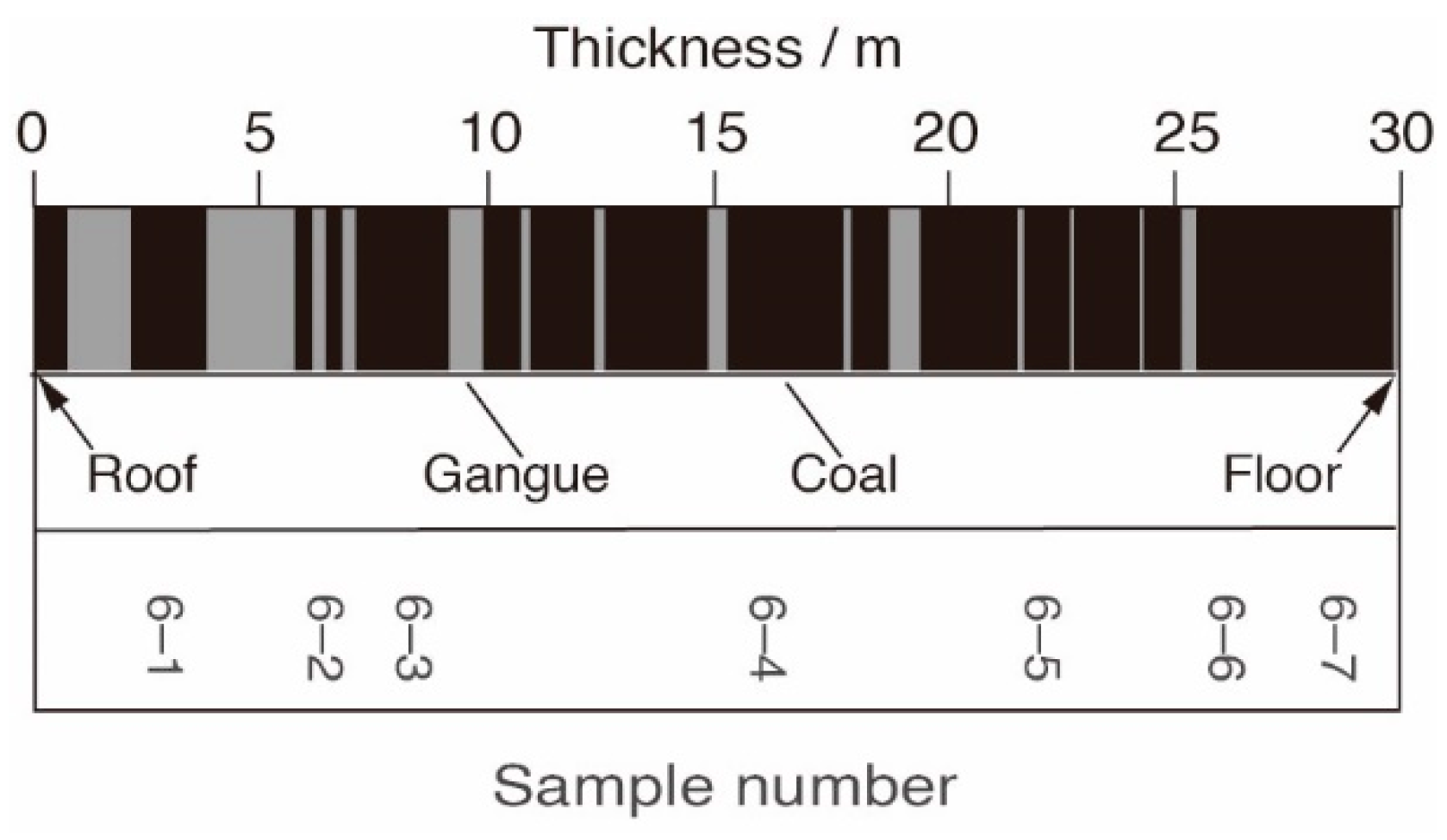
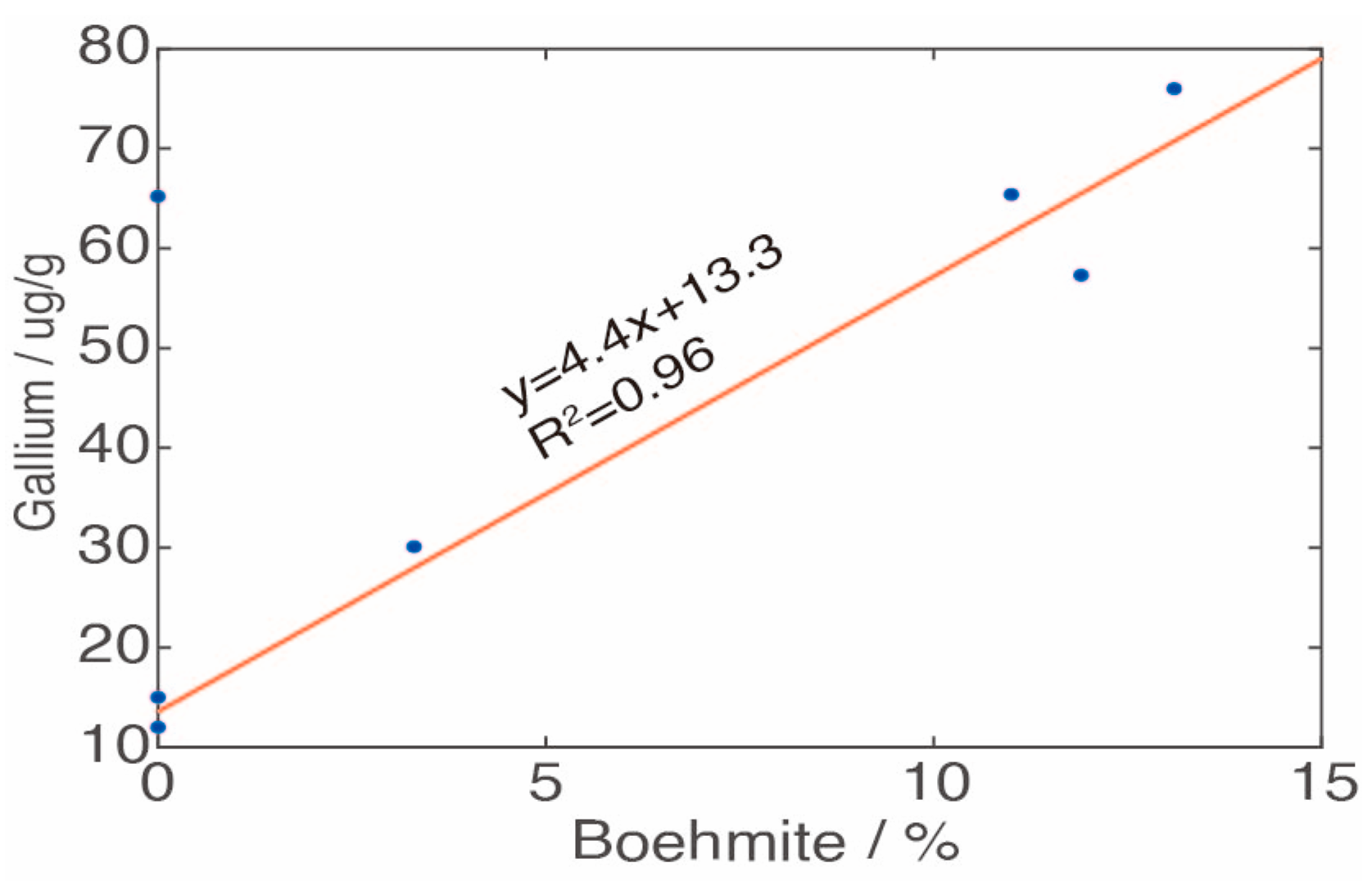



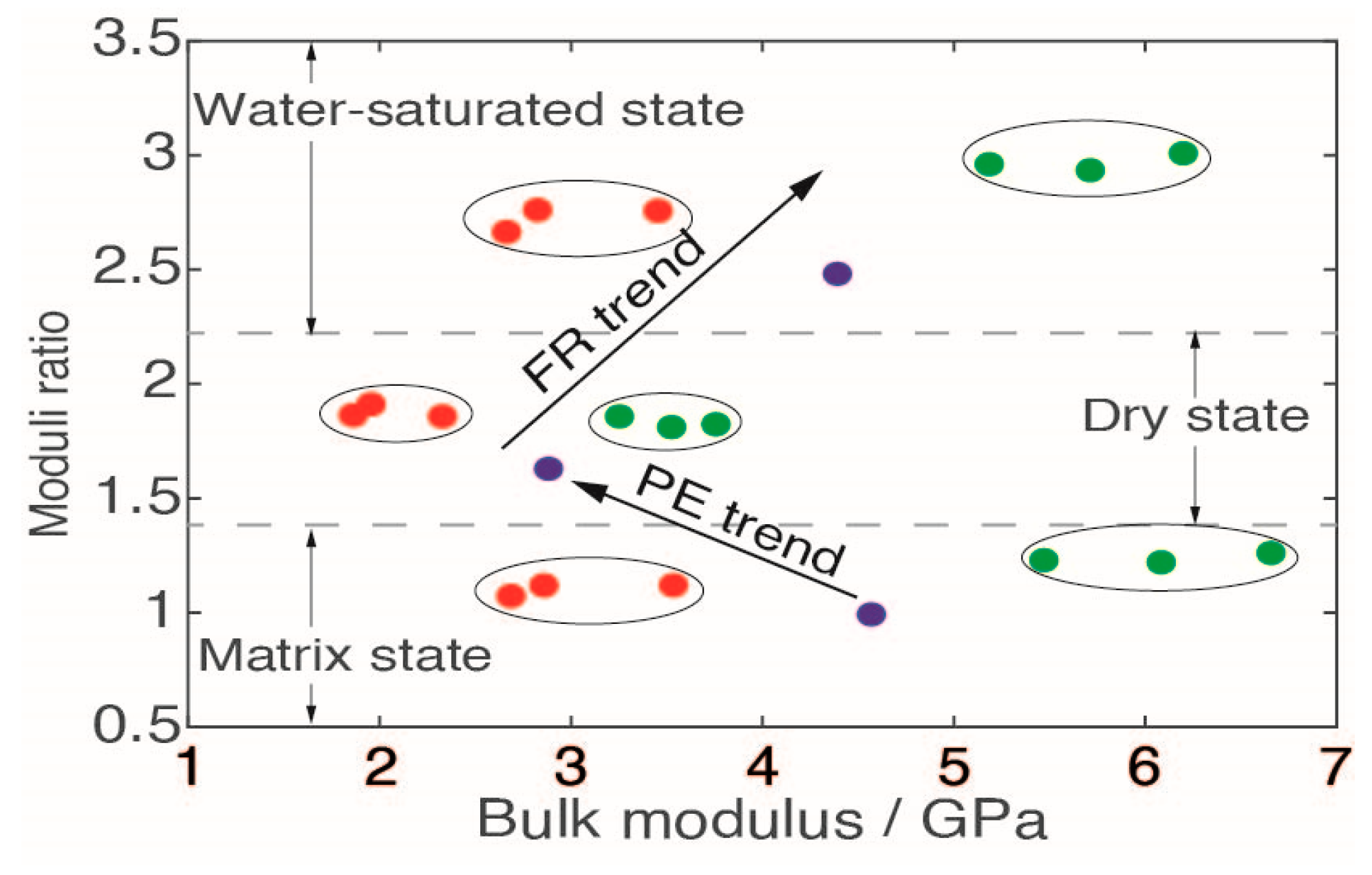
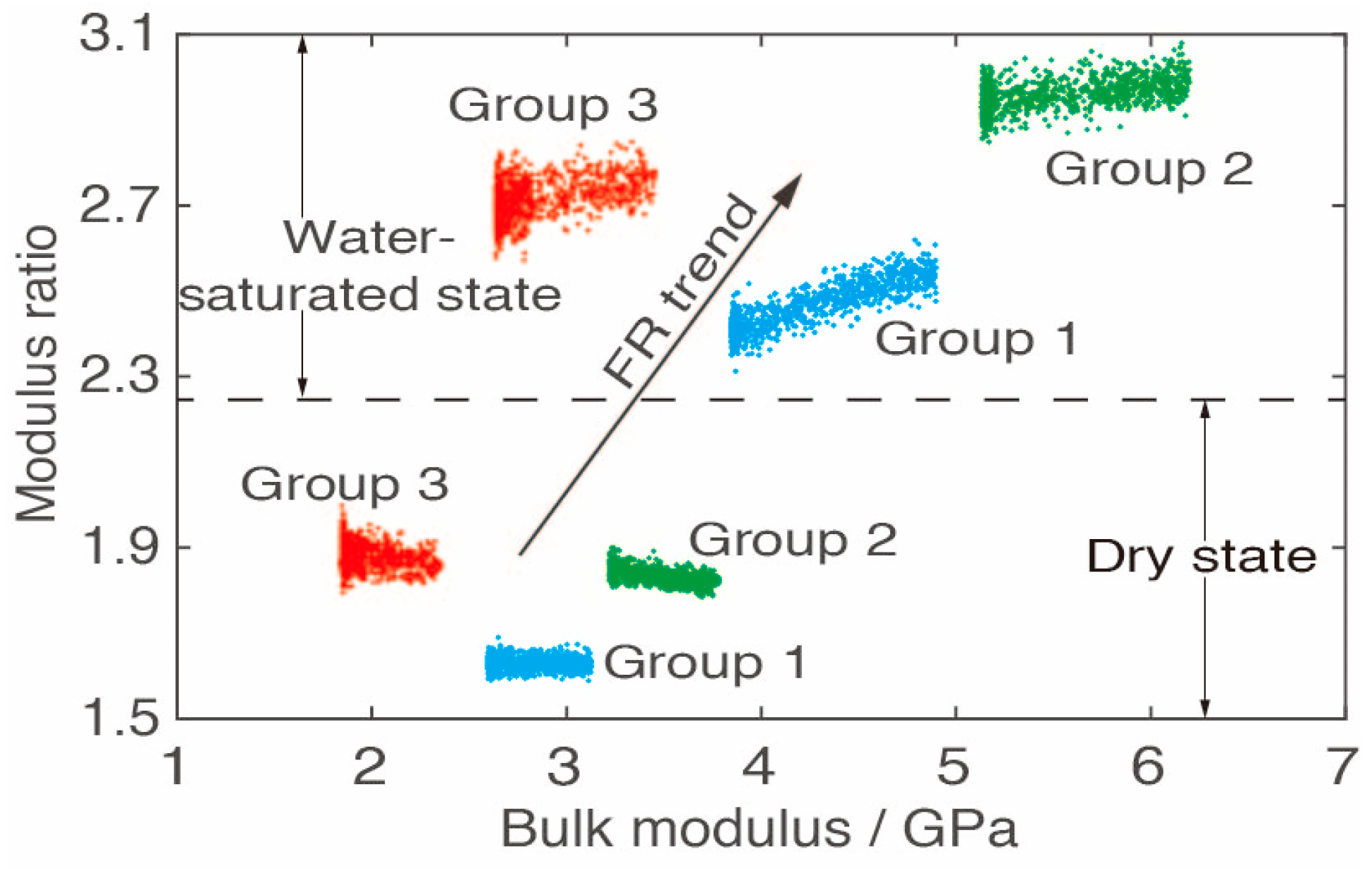

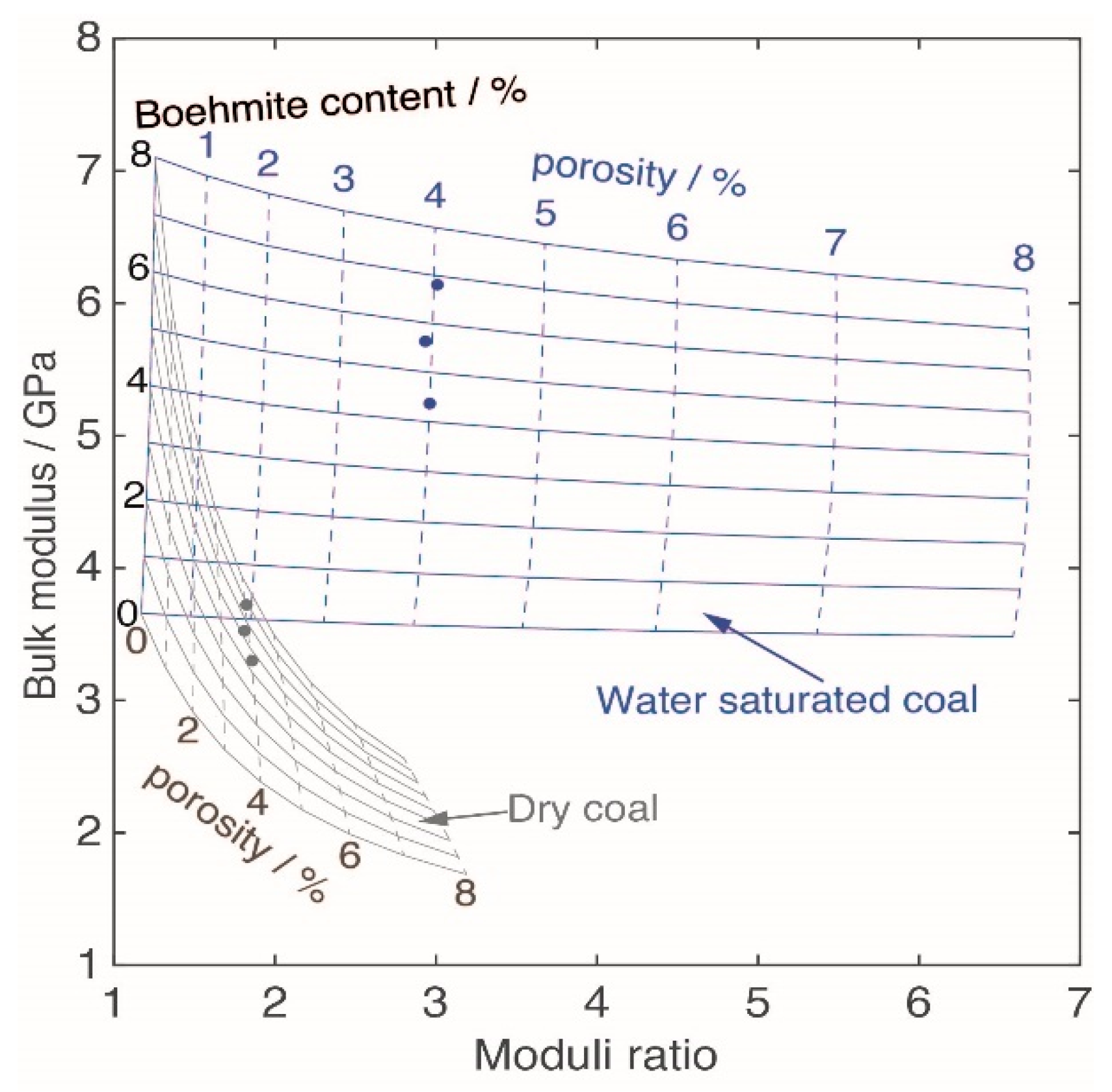
| Core | 6–1 | 6–2 | 6–3 | 6–4 | 6–5 | 6–6 | 6–7 | |
|---|---|---|---|---|---|---|---|---|
| Content | ||||||||
| Organic | 77.5 | 76.7 | 80.1 | 82.9 | 84.4 | 76.3 | 79.9 | |
| Clay | 5.5 | 4.3 | 3.6 | 4.4 | 11.4 | 22.0 | 19.5 | |
| Pyrite | 0.0 | 0.0 | 0.0 | 0.0 | 0.9 | 0.4 | 0.4 | |
| Quartz | 16.3 | 4.7 | 1.6 | 0.9 | 0.0 | 0.2 | 0.2 | |
| Calcite | 0.7 | 0.8 | 0.8 | 0.0 | 0.0 | 1.1 | 0.0 | |
| Siderite | 0.0 | 0.0 | 0.8 | 0.0 | 0.0 | 0.0 | 0.0 | |
| Rutile | 0.0 | 1.6 | 0.0 | 0.8 | 0.0 | 0.0 | 0.0 | |
| Boehmite | 0.0 | 11.9 | 13.1 | 11.0 | 3.3 | 0.0 | 0.0 | |
| Gallium | 12.0 | 57.3 | 76.0 | 65.4 | 30.1 | 65.4 | 15.0 | |
| Core | 6–1 | 6–2 | 6–3 | 6–4 | 6–5 | 6–6 | 6–7 |
|---|---|---|---|---|---|---|---|
| 6–1 | 1 | ||||||
| 6–2 | 0.83 | 1 | |||||
| 6–3 | 0.74 | 0.99 | 1 | ||||
| 6–4 | 0.80 | 1.00 | 0.99 | 1 | |||
| 6–5 | 0.95 | 0.93 | 0.88 | 0.92 | 1 | ||
| 6–6 | 0.77 | 0.96 | 0.97 | 0.97 | 0.91 | 1 | |
| 6–7 | 0.96 | 0.84 | 0.76 | 0.83 | 0.98 | 0.84 | 1 |
| Content | Organic | Clay | Pyrite | Quartz | Calcite | Siderite | Rutile | Boehmite | Gallium |
|---|---|---|---|---|---|---|---|---|---|
| Organic | 1 | ||||||||
| Clay | −0.18 | 1 | |||||||
| Pyrite | 0.46 | 0.60 | 1 | ||||||
| Quartz | −0.42 | −0.41 | −0.46 | 1 | |||||
| Calcite | −0.83 | 0.00 | −0.40 | 0.30 | 1 | ||||
| Siderite | 0.06 | −0.37 | −0.31 | −0.14 | 0.29 | 1 | |||
| Rutile | −0.19 | −0.47 | −0.45 | 0.00 | 0.06 | −0.24 | 1 | ||
| Boehmite | 0.18 | −0.75 | −0.52 | −0.22 | 0.05 | 0.54 | 0.62 | 1 | |
| Gallium | −0.07 | −0.24 | −0.34 | −0.47 | 0.42 | 0.50 | 0.34 | 0.72 | 1 |
| Core Number | 6–1 | 6–2 | 6–3 | 6–4 | 6–5 | 6–6 | 6–7 |
|---|---|---|---|---|---|---|---|
| Organic | 85.77 | 86.66 | 88.89 | 90.2 | 88.44 | 80.2 | 83.1 |
| Clay | 5.01 | 4.00 | 3.29 | 3.94 | 9.83 | 19.03 | 16.69 |
| Pyrite | 0.00 | 0.00 | 0 | 0 | 0.25 | 0.11 | 0.11 |
| Quartz | 8.85 | 2.61 | 0.87 | 0.48 | 0 | 0.1 | 0.1 |
| Calcite | 0.37 | 0.43 | 0.43 | 0 | 0 | 0.55 | 0 |
| Siderite | 0.0 | 0.0 | 0.3 | 0 | 0 | 0 | 0 |
| Rutile | 0.0 | 0.55 | 0 | 0.27 | 0 | 0 | 0 |
| Boehmite | 0.0 | 5.75 | 6.22 | 5.12 | 1.48 | 0 | 0 |
| Content | Organic | Clay | Pyrite | Quartz | Calcite | Siderite | Rutile | Boehmite |
|---|---|---|---|---|---|---|---|---|
| Bulk modulus | 2.9 | 1.5 | 147.4 | 37.0 | 76.8 | 136.4 | 244.8 | 87.5 |
| Shear modulus | 2.7 | 1.4 | 132.5 | 44.0 | 32.0 | 66.5 | 63.5 | 64.03 |
| Density | 1.3 | 1.58 | 4.93 | 2.65 | 2.71 | 3.8 | 4.25 | 3.04 |
| Core Number | True Contents | Interpreted Contents | Absolute Errors | |||
|---|---|---|---|---|---|---|
| Boehmite /vol% | Gallium /ppm | Ga (WS) /ppm | Ga (dry) /ppm | Ga (WS) /ppm | Ga (dry) /ppm | |
| 6–2 | 5.8 | 57.3 | 65.3 | 63.6 | 8.0 | 6.3 |
| 6–3 | 6.2 | 76.0 | 76.1 | 77.7 | 0.1 | 1.7 |
| 6–4 | 5.1 | 65.4 | 54.5 | 53.7 | 10.9 | 11.7 |
Publisher’s Note: MDPI stays neutral with regard to jurisdictional claims in published maps and institutional affiliations. |
© 2022 by the authors. Licensee MDPI, Basel, Switzerland. This article is an open access article distributed under the terms and conditions of the Creative Commons Attribution (CC BY) license (https://creativecommons.org/licenses/by/4.0/).
Share and Cite
Chen, T.; Song, X. Are Coal-Hosted Gallium-Rich Ores Elastically Detectable: A Rock-Physics Modeling Perspective. Minerals 2022, 12, 1619. https://doi.org/10.3390/min12121619
Chen T, Song X. Are Coal-Hosted Gallium-Rich Ores Elastically Detectable: A Rock-Physics Modeling Perspective. Minerals. 2022; 12(12):1619. https://doi.org/10.3390/min12121619
Chicago/Turabian StyleChen, Tongjun, and Xiong Song. 2022. "Are Coal-Hosted Gallium-Rich Ores Elastically Detectable: A Rock-Physics Modeling Perspective" Minerals 12, no. 12: 1619. https://doi.org/10.3390/min12121619





